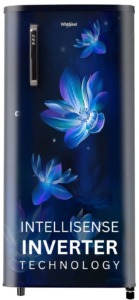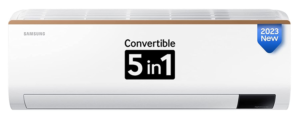Table of Contents

When it comes to choosing the right cooling appliance for your needs, understanding the different energy efficiency ratings is crucial. EER, SEER, and ISEER are terms commonly used to measure the efficiency of air conditioners. In this comprehensive comparison guide, we will explore the intricacies of each rating, their significance, and how they can help you make an eco-friendly and cost-effective choice for your cooling needs. What is ISEER Rating?
Efficiency = Output / input
EER (Energy Efficiency Ratio)
The EER rating is a measure of an air conditioner’s cooling efficiency under specific conditions. It is calculated by dividing the cooling capacity of the AC unit (in British Thermal Units or BTUs) by its power consumption (in watts). The higher the EER rating, the more energy-efficient the air conditioner is. EER is typically used to assess the performance of air conditioners operating under steady-state conditions.
SEER (Seasonal Energy Efficiency Ratio)
SEER takes energy efficiency assessment a step further by considering the AC unit’s performance over an entire cooling season. Unlike EER, SEER accounts for varying weather conditions and fluctuating cooling demands. SEER is calculated by dividing the total cooling output (in BTUs) over a cooling season by the total energy consumed (in watt-hours) during the same period. A higher SEER rating indicates better energy efficiency and cost savings.
ISEER (Indian Seasonal Energy Efficiency Ratio)
ISEER full form is Indian Seasonal Energy Efficiency Ratio
ISEER is a rating system specifically designed for air conditioners in India. It further refines the SEER concept by incorporating different climate zones in the country and assigning weights to each zone. This rating enables consumers to make more accurate comparisons between air conditioner models based on their specific geographic location. ISEER ratings provide a standardized measure of energy efficiency across different climatic conditions in India, helping consumers make informed choices.
ISEER stands for Indian Seasonal Energy Efficiency Ratio. It is a rating system for air conditioners in India that measures their energy efficiency. The higher the ISEER rating, the more energy-efficient the air conditioner.
ISEER is calculated as the ratio of the total cooling load (amount of heat removed) to the total amount of energy consumed by the air conditioner over a typical Indian cooling season. The cooling season is defined as the period from April to September, when the average temperature in India is above 24 degrees Celsius.
The ISEER rating is used to assign star ratings to air conditioners. Air conditioners with a higher ISEER rating will have a higher star rating. The star ratings are as follows:
- 1-star: ISEER 3.3 to 3.49
- 2-star: ISEER 3.5 to 3.79
- 3-star: ISEER 3.8 to 4.39
- 4-star: ISEER 4.4 to 4.99
- 5-star: ISEER 5 or above
The ISEER rating is a useful tool for consumers to compare the energy efficiency of different air conditioners. Air conditioners with a higher ISEER rating will use less energy and save you money on your electricity bills.
Here are some of the benefits of choosing an air conditioner with a high ISEER rating:
- You will save money on your electricity bills.
- You will help to reduce your carbon footprint.
- You will create a more comfortable and healthy living environment.
If you are looking for an energy-efficient air conditioner, be sure to check the ISEER rating. The higher the ISEER rating, the more energy-efficient the air conditioner and the more money you will save on your electricity bills.
Here are some additional things to keep in mind when choosing an air conditioner:
- The size of the air conditioner should be appropriate for the size of the room or space you are cooling.
- The type of air conditioner (window-mounted, split-system, etc.) should be chosen based on your needs and preferences.
- The features of the air conditioner (such as remote control, timer, etc.) should be considered.
- The price of the air conditioner should also be a factor in your decision.
By considering all of these factors, you can choose an air conditioner that is both energy-efficient and meets your needs.
Key Differences between EER, SEER, and ISEER:
- EER focuses on cooling efficiency under specific conditions, while SEER considers overall seasonal performance.
- ISEER extends SEER by accounting for different climate zones in India, providing location-specific energy efficiency information.
- SEER and ISEER ratings are more comprehensive and reliable indicators of an air conditioner’s efficiency compared to EER.
- Scope of Evaluation:
- EER: Single point evaluation based on cooling capacity and power input.
- SEER: Seasonal evaluation considering various climatic conditions.
- ISEER: Seasonal evaluation tailored for Indian climatic conditions.
- Calculation Complexity:
- EER: Simple division of cooling capacity by power input.
- SEER: Requires data collection over an entire cooling season for accurate calculation.
- ISEER: Complex calculation considering multiple data points.
- Regional Applicability:
- EER: Widely used globally but lacks consideration of regional variations.
- SEER: Commonly used in many regions but not specifically tailored for a particular country.
- ISEER: Specifically designed for the Indian market, considering the country’s diverse climate.
Calculating EER, SEER, and ISEER: The Formula Revealed
Calculating EER:
EER = (Cooling Capacity in BTUs per hour) / (Power Input in Watts)
Calculating SEER:
SEER = (Total Cooling Output over a Cooling Season in BTUs) / (Total Energy Input over the Cooling Season in Watt-Hours)
Calculating ISEER:
ISEER = (Total Cooling Output over a Defined Period in BTUs) / (Total Energy Input over the Defined Period in Watt-Hours)
How is ISEER Rating Calculated?
The ISEER Rating is calculated based on the ratio of total heat removed by the air conditioner to the total electricity consumed over a defined period. This period includes different climatic conditions representative of the appliance’s usage throughout the year. The Bureau of Energy Efficiency (BEE), an Indian governmental agency, sets the testing standards and procedures for determining the ISEER Rating of appliances.
Interpreting ISEER Values
Understanding ISEER Rating Labels: ISEER Ratings are usually displayed on labels affixed to air conditioners and heat pumps. These labels provide valuable information about the appliance’s energy efficiency. The higher the ISEER Rating, the more energy-efficient the appliance is.
Comparing ISEER Ratings: When comparing ISEER Ratings between different appliances, consider choosing one with a higher value as it will consume less electricity for the same cooling output.
Optimal ISEER Ratings: As per the BEE guidelines, the minimum ISEER Rating for air conditioners sold in India varies based on capacity and type. Always aim for a higher ISEER Rating, as it ensures a more eco-friendly and cost-effective appliance.
How ISEER Rating Impacts Different Appliances
ISEER Rating for Air Conditioners: For air conditioners, ISEER Rating plays a vital role in determining their energy efficiency. Higher ISEER Ratings in air conditioners ensure better cooling performance, reduce energy consumption, and contribute to environmental preservation.
ISEER Rating for Heat Pumps: In heat pumps, ISEER Rating evaluates their efficiency in providing both heating and cooling. Heat pumps with higher ISEER Ratings are more energy-efficient, making them a preferable choice for climate control in various settings.
ISEER Rating for Commercial Appliances: ISEER Rating is equally applicable to commercial and industrial air conditioning and heat pump systems. Energy-efficient commercial appliances with higher ISEER Ratings can significantly lower operational costs and reduce the carbon footprint of businesses.
Also Read How to Fix Water Leakage from Split AC [Guide]
Tips for Choosing Appliances Based on ISEER Rating
Consider Your Requirements: Identify your cooling or heating needs and select an appliance that matches your requirements. Consider the size of the area you want to cool or heat, the frequency of usage, and the climatic conditions of your location.
Compare Different Brands and Models: Always compare ISEER Ratings of various brands and models before making a purchase. Look for appliances that offer high energy efficiency and come from reputable manufacturers with a history of producing reliable and sustainable products.
Seek Expert Advice: Consult with HVAC experts or experienced professionals who can guide you in choosing the best appliance for your specific needs. They can help you navigate the technical specifications and understand the implications of ISEER Ratings.
FAQs – What is ISEER Rating?
Q: What is the ideal EER, SEER, or ISEER rating for an air conditioner?
A: The ideal rating depends on various factors, including personal preferences, budget, and climate conditions. Higher ratings generally indicate better energy efficiency and cost savings.
Q: Can I compare EER, SEER, and ISEER ratings across different air conditioner brands?
A: Yes, these ratings are standardized and can be used to compare energy efficiency between different brands and models.
Q: Are higher-rated air conditioners more expensive?
A: Generally, air conditioners with higher ratings tend to be more energy-efficient and cost-effective in the long run. While they may have a higher upfront cost, they can lead to significant savings on energy bills over time.
Also Read How to Hide or Decorate Split AC Piping
Conclusion
Understanding the differences between EER, SEER, and ISEER ratings is crucial when choosing an air conditioner. EER provides a baseline efficiency measurement, while SEER and ISEER offer a more comprehensive assessment of cooling performance over a season or in specific geographic locations. Consider these ratings alongside your specific requirements and climate conditions to make an informed decision about an energy-efficient air conditioning system.
Remember, higher-rated air conditioners may have a higher upfront cost but can lead to substantial long-term savings on energy consumption. Prioritize energy efficiency and choose an AC unit that suits your needs while considering the environmental impact.



